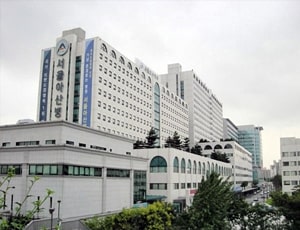Treatment cost

Asan Medical Centre located in Seoul, South Korea is accredited by ISO. Also listed below are some of the most prominent infrastructural details:

People from all age groups can be affected by ear disorders and hearing impairment problems. In the United States, a survey revealed that under the age of 65, over 60 percent of the population suffers from problems related to hearing loss. However, almost 25 percent of people aged above 65 experience a significant loss of hearing. Thankfully, different types of ENT surgeries are available to treat problems related to the ear.
Most often, people are diagnosed with problems related to the eardrum, or tympanum, and the infection in the cells of the mastoid bone. The tympanum is the thin membranous structure present between the outer and the middle ear. It vibrates when sound waves hit on it and this enables us to hear.
A repair surgery called tympanoplasty is required to treat a perforation or hole in the eardrum. The middle ear is sterile but due to rupture of the eardrum, an infection can also occur. It may also be required for repairing of tiny bones present behind the eardrum or ossicles in the mastoid bone. This repair is known as mastoidectomy.
Tympanoplasty and mastoidectomy are therefore conducted together in many cases. This procedure is known as tympano-mastoidectomy.
Several reasons may cause loss of hearing, including the following:
Birth defect
An ear infection that has grown very severe and left untreated for long
The injury suffered by the ear
Ear subjected to excessive levels of noise
Hearing loss as a result of age
Other reasons
Some of the common symptoms of a puncture in eardrum include the following:
Sharp pain in the ear that disappears abruptly
Excessive pressure, which will suddenly disappear with the rupture and pus formation in the ear
Loss of hearing
Dizziness
Type 1 tympanoplasty or myringoplasty is the surgery that ensures restoration of the eardrum that got perforated with drafting
Type II tympanoplasty addresses membrane perforations with erosion in the bone malleus. Grafting is done on the incus bone or in the remains of the malleus.
Type III tympanoplasty is meant for destruction of two ossicles and intact and mobile stapes bone. A graft is placed on the stapes and it provides protection for the total assembly.
Type IV tympanoplasty is useful for cases of ossicular destruction, which has all or part of the arch of stapes included. A graft is placed around the mobile stapes footplate
Type V tympanoplasty is useful when the footplate of the stapes bone is fixed.
For treating Cholesteatoma, tympanoplasty can be combined with stapedectomy and mastoidectomy and in many cases, a second operation is required to ensure the infection is totally eradicated.
The tympanoplasty surgery is performed with intravenous sedation and local anesthesia. An incision is made into the ear canal section and from the bony ear canal, the remaining eardrum is elevated and lifted forward. Under the operating microscope, the ear structures can be seen clearly. An incision behind the ear is made if the hole is very large or far forward. It ensures that the entire outer ear is forwarded, giving better access to the perforation.
The perforated remnant part is rotated forward after the hole is exposed and now the ossicles are inspected. Scar tissue and bands can surround the bones and they are removed with a laser or micro hooks. Now the ossicular chain is pressed to check its mobility and functionality. If it is found to be mobile, then the rest of the surgery aims at repairing the defect of the drum.
From the tragus, which is the cartilaginous lobe of skin in front of the ear, or from the back of the ear,
If the bones in the ear suffer from erosion, then ossicular reconstruction is advised. At times it can be determined before surgery but in other cases, erosion is visible only when the ear is completely opened under the microscope. The reconstruction can happen at the time of the eardrum construction. Bone erosion can happen at the tip of the incus or anvil. A discontinuity between the stapes and the incus has to be resolved.
A small piece of bone or cartilage can be inserted from some other part of the body of the patient if the gap between the two cones mentioned above is small. But if the gap is large, then the anvil bone is removed and remodeled to give a shape of a tooth with the help of the operating microscope. After reshaping the prosthesis, it is placed between the malleus and the stapes, and ossicular chain continuity is then re-established.
In some other ossicular construction, the malleus can get fixated by bony ingrowth or scar tissue to the ear’s lateral wall. The plastic-type or
Usually, a patient is discharged within two to three hours of the surgery. Along with a mild pain reliever, some antibiotics are also administered. After 10 days, the patient is again expected to visit so that packing can be removed and graft success can be checked.
Patients are advised to keep water away from the surgical site and avoid blowing of the nose. If the patient is suffering from cold and allergies, then decongestants are prescribed. Within 5 to 6 days, the patients can resume a normal life. After 3 weeks of the surgery, the packing is removed under the operating microscope and at this point, the grafting success can be completely determined.
Care must be taken by the patient to soak the ear canal with antibiotics to keep infection at bay. Shearing forces of excessive tension should not be felt by the graft. The surgeon will advise the patient to avoid activities that alter the tympanic pressure, including using a straw to drink or blowing of the nose. Finally, a hearing test is performed after 4 to 6 weeks of the surgery.
Ask your healthcare adviser for the best multiple options and choose the one that meets your expectations
Different hospitals have different pricing policy when it comes to the cost of Tympanoplasty in Seoul. The cost quoted by some of the best hospitals for Tympanoplasty in Seoul generally covers the pre-surgery investigations of the patient. Typically, the package cost of Tympanoplasty in Seoul includes the expenses related to the surgeon's fee, anesthesia, hospital, meals, nursing and ICU stay. A prolonged hospital stay due to delayed recovery, new diagnosis and complications after surgery may increase the cost of Tympanoplasty in Seoul.
There are many hospitals that perform Tympanoplasty in Seoul. Some of the most renowned hospitals for Tympanoplasty in Seoul include the following:
After Tympanoplasty in Seoul, the patient is supposed to stay in guest house for another 8 days. This duration of stay is recommended to complete all the necessary follow-ups and control tests to ensure that the surgery was successful.
Apart from the cost of Tympanoplasty, the patient is also required to pay additionally for daily meals and guest house accommodation. These are the charges for daily meals and accommodation outside the hospital. The per day cost in this case may range from 40 USD.
The patient is supposed to stay at the hospital for about 2 Days after Tympanoplasty surgery for monitoring and care. The patient is subjected to several biochemistry and radiological scans to see that everything is okay and the recovery is on track. After making sure that patient is clinically stable, discharge is planned.
There are around 1 Hospitals hospitals in Seoul that offer Tympanoplasty to international patients. These hospitals are approved to perform the surgery and have proper infrastructure to handle Tympanoplasty patients. Additionally, these hospitals are known to comply with the international standards as well as local legal requirements for the treatment of patients.
Some of the most sought after doctors for Tympanoplasty in Seoul are:
One of the most popular destinations for medical tourism in the world, Seoul, the capital of South Korea attracts around 60% of the patients traveling to the country for quality care. More than 2.76 million International patients travel to South Korea on average. This can be attributed to high-quality medical services, economical healthcare services, and affordable packages that combine both treatment and relaxation. The number of healthcare organizations in Seoul tally up to 21,507. Out of these, 14 are advanced hospitals that provide a range of healthcare services. The high success rate of cancer treatment, plastic surgery, and organ transplants attract the majority of foreign patients to Seoul. Hundreds and thousands of patients from abroad travel to Seoul for cosmetic and plastic surgery. The largest proportion of medical tourists belonged to China and the United States. The top hospitals in Seoul have well-trained medical staff along with coordinators that help international patients availing treatments without any issues.
Seoul has a wide network of internationally accredited hospitals that are using cutting-edge medical technology to treat patients. Some of the top hospitals in Seoul are:
The doctors in Seoul obtained their medical education and training from some of the most reputed medical institutions around the world. Some of the top doctors in Seoul are:
Seoul is a major healthcare center and is well connected to the major cities in the globe via air. You can reach the city by international flights. If you are planning to travel, then we can assist you in making the journey hassle-free.